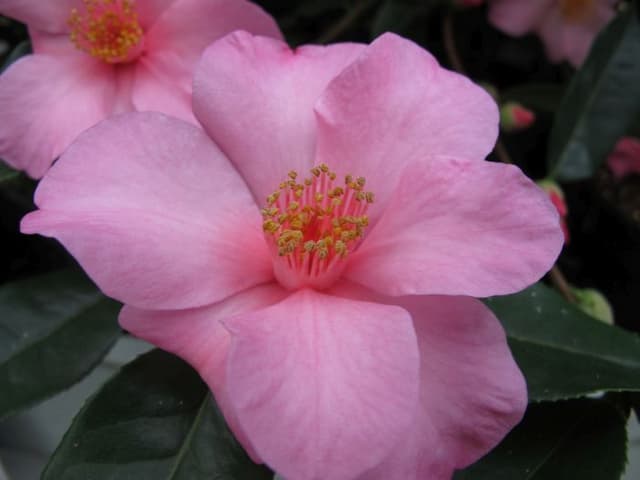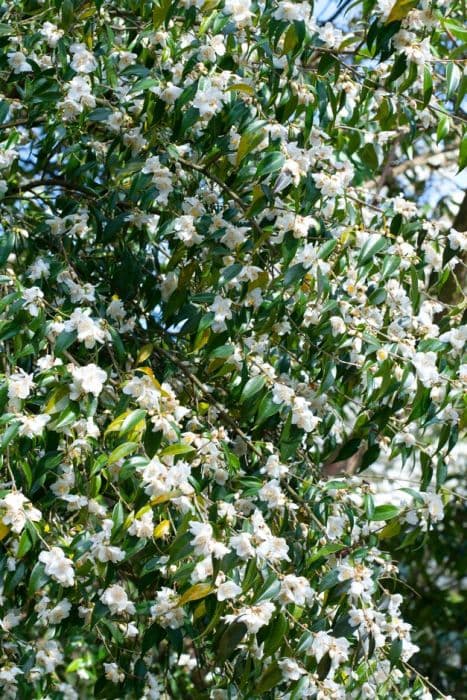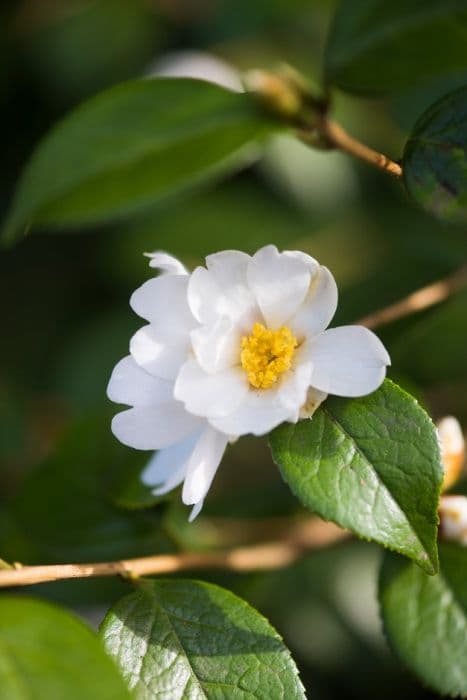Japanese Camellia Camellia japonica 'Onetia Holland'

ABOUT
Camellia japonica 'Onetia Holland' is a visually striking ornamental plant known for its lush, glossy green leaves and large, showy flowers. The leaves display a rich dark green color and have an ovate shape with a slightly serrated edge, contributing to the plant's dense and evergreen foliage. Most remarkable are the flowers, which are typically a deep pink or sometimes a bright red, offering a bold splash of color in the landscape. The blooms are quite substantial, featuring multiple layers of petals that create a peony-like effect and adding to the plant's opulent feel. The petals have a soft, velvety texture and are often arranged in a symmetrical, formal double-flower form, which means that the flowers have many rows of petals and no visible center stamens. The overall visual impact of the Camellia japonica 'Onetia Holland' is one of classic elegance and beauty, making it a favored choice for gardens that aim to showcase year-round interest and vibrant color.
About this plant
 Names
NamesFamily
Theaceae
Synonyms
Japanese Camellia, Camellia, Rose of Winter
Common names
Camellia japonica 'Onetia Holland'.
 Toxicity
ToxicityTo humans
Camellia japonica, commonly known as Japanese camellia, is not considered toxic to humans. There are generally no symptoms of poisoning because it is not known to have any toxic principles that affect humans upon ingestion. It's always a good practice, however, to avoid consuming parts of ornamental plants due to potential pesticide exposure and the risk of gastrointestinal discomfort from non-food plants.
To pets
Camellia japonica, more commonly known as Japanese camellia, is generally not considered toxic to pets. There are no specific symptoms associated with poisoning from this plant, as it is not known to contain substances that are harmful to pets. Nonetheless, ingestion of non-food items, including parts of ornamental plants, can sometimes result in mild gastrointestinal upset for pets, so it is advisable to prevent pets from chewing on these plants.
 Characteristics
CharacteristicsLife cycle
Perennials
Foliage type
Evergreen
Color of leaves
Dark green
Flower color
Pink
Height
6-10 feet (1.8-3 meters)
Spread
5-7 feet (1.5-2.1 meters)
Plant type
Shrub
Hardiness zones
7
Native area
Japan
Benefits
 General Benefits
General Benefits- Ornamental appeal: Camellia japonica 'Onetia Holland' is widely appreciated for its beautiful pink flowers, which add aesthetic value to gardens and landscapes.
- Year-round interest: While the main blooming season is in late winter to early spring, the glossy green leaves of Camellia japonica provide visual interest throughout the year.
- Drought tolerance: Once established, the plant is relatively tolerant to dry conditions, making it a suitable choice for gardens in areas with water restrictions.
- Shade tolerance: Camellia japonica can thrive in partial shade, making it a versatile plant for gardeners with shaded areas.
- Pollinator attraction: The flowers attract pollinators such as bees, which are essential for the health of many ecosystems and agriculture.
- Low maintenance: With minimal pruning and care, Camellia japonica 'Onetia Holland' can thrive, making it a convenient option for both novice and experienced gardeners.
 Medical Properties
Medical Properties- This plant is not used for medical purposes.
 Air-purifying Qualities
Air-purifying QualitiesThis plant is not specifically known for air purifying qualities.
 Other Uses
Other Uses- Camellia japonica petals can be used for fabric dyeing, giving a range of colors from pink to yellow depending on the mordant used.
- The waxy leaves of Camellia japonica can be used in the crafting of temporary small containers or as decorative plating for special culinary presentations.
- Dried and pressed Camellia japonica flowers can make beautiful additions to papermaking, embedding the petals into the handmade paper for a unique texture and appearance.
- The fallen petals of Camellia japonica can be used as a natural confetti for events, reducing the environmental impact compared to synthetic alternatives.
- The wood of the Camellia japonica plant, being hard and dense, is suitable for the creation of small woodcarvings or instruments such as flutes.
- The thick, glossy leaves of the Camellia japonica can serve as bookmarks, especially after being dried and treated to preserve their shape and color.
- When trimmed properly, the branches of Camellia japonica can be used for bonsai, creating miniature landscapes for display and horticultural art.
- Camellia japonica seed oil, though more commonly associated with Camellia oleifera, can be used in woodworking as a natural tool lubricant or to finish wood surfaces.
- Petals of the Camellia japonica can be added to potpourri mixtures, contributing a subtle fragrance and a splash of color.
- Cultivars of Camellia japonica with particularly intricate or colorful flowers can be used in floral photography, providing an attractive subject for artists and hobbyists.
Interesting Facts
 Feng Shui
Feng ShuiThe Camellia is not used in Feng Shui practice.
 Zodiac Sign Compitability
Zodiac Sign CompitabilityThe Camellia is not used in astrology practice.
 Plant Symbolism
Plant Symbolism- Admiration: The Camellia japonica often symbolizes deep admiration for someone's qualities and spirit.
- Perfection: Its delicate beauty and flawless blooms represent the idea of perfection and excellence.
- Love: Camellias are commonly given as a symbol of romantic love, particularly expressing the longing for someone far away.
- Longevity & Faithfulness: The longevity of the Camellia's bloom is seen as a symbol of the enduring nature of love and the faithfulness between partners.
- Affection: As a gift, Camellias can convey heartfelt affection and genuine emotion towards the recipient.
 Water
WaterJapanese camellias, including 'Onetia Holland', prefer consistent moisture and should be watered deeply when the top inch of soil feels dry to the touch. This typically equates to about 1 to 1.5 inches of water per week, either from rainfall or manual watering. During the growing season in spring and summer, this may mean watering every 5 to 7 days, depending on the weather conditions and soil drainage. In the cooler months of fall and winter, watering can be reduced to every 10 to 14 days. It's important to avoid overwatering, which can lead to root rot, so always check the soil moisture before watering.
 Light
LightJapanese camellias like 'Onetia Holland' thrive best in partial shade where they can receive filtered sunlight. An ideal spot is under the high, dappled light of taller trees or on the north or east side of a building. Direct afternoon sunlight can be too intense and may cause leaf scorch, especially in hotter climates. However, they require some light to flower well, so avoid deep shade locations.
 Temperature
TemperatureJapanese camellias, such as 'Onetia Holland', are hardy in USDA zones 7 to 9 and can typically withstand minimum temperatures of 0 to 10 degrees Fahrenheit. They perform ideally in temperatures ranging from 60 to 75 degrees Fahrenheit. However, they may struggle or sustain damage if temperatures drop below freezing for prolonged periods or exceed 85 degrees Fahrenheit during their blooming period.
 Pruning
PruningPrune Japanese camellias such as 'Onetia Holland' to maintain their shape and promote air circulation within the plant, which helps prevent disease. The best time to prune is after blooming, before the new buds set for the next season, typically late winter or early spring. Thin out crowded branches and cut back any leggy growth or dead wood. This usually needs to be done annually or as necessary if the plant becomes overgrown or misshapen.
 Cleaning
CleaningAs needed
 Soil
SoilThe Japanese Camellia 'Onetia Holland' thrives in well-draining, acidic soil with a pH between 5.5 and 6.5. A suitable soil mix can be made by combining equal parts of peat moss, pine bark, and coarse sand or perlite, ensuring proper aeration and drainage to prevent root rot. Regular mulching with organic matter like pine needles can help maintain soil acidity and moisture.
 Repotting
RepottingJapanese Camellias like 'Onetia Holland' typically need repotting every 2 to 3 years, preferably in the spring before the growing season starts. This schedule helps to refresh the soil and provide room for root growth, however, older plants may be repotted less frequently if they are in large containers and not root-bound.
 Humidity & Misting
Humidity & MistingJapanese Camellia 'Onetia Holland' prefers moderate to high humidity levels, ideally between 50% and 80%. These conditions mimic their natural humid, woodland habitats. Supplemental humidity can be provided by a pebble tray with water or a humidifier if indoor air is too dry.
 Suitable locations
Suitable locationsIndoor
Keep in indirect light, high humidity, and acidic soil.
Outdoor
Place in partial shade, shelter from cold winds, well-drained soil.
Hardiness zone
7-9 USDA
 Life cycle
Life cycleCamellia japonica 'Onetia Holland', commonly called Japanese camellia, begins its life cycle when the seeds are sown in a well-draining soil mix; germination may take several weeks to months. After germination, the seedling stage occurs, marked by the growth of the first true leaves, and it requires shade and protection from elements. As it matures into a young plant, the camellia undergoes a vegetative stage characterized by the development of a strong root system and foliage expansion. Transitioning to the adult stage, the Japanese camellia will exhibit substantial bushy growth and begin to flower, typically during late winter to early spring, showcasing attractive pink, red, or white blossoms. Once pollinated, the flowers develop into seed capsules which ripen by late summer or fall, completing the reproductive cycle. After several years, as long as conditions allow, the plant gradually reaches senescence where growth slows, and it may become less prolific in flowering before eventually dying.
 Propogation
PropogationPropogation time
Spring-Early Summer
The Japanese camellia, specifically the 'Onetia Holland' variety, is most commonly propagated through semi-hardwood cuttings. This method is favored for its efficiency and reliability. Ideally, the propagation time is in late summer to early fall, when the current year's growth has begun to mature. To propagate, cut a 4 to 6-inch (10 to 15 cm) section from a healthy branch, making sure to include at least two to three sets of leaves. The lower leaves are removed, and the cut end is often dipped in a rooting hormone to encourage root growth. The cutting is then placed in a well-draining soil mix, ensuring at least one set of leaves remains above the soil surface. The cutting should be kept moist and in a warm, indirect light until roots have developed and it can be transplanted.









